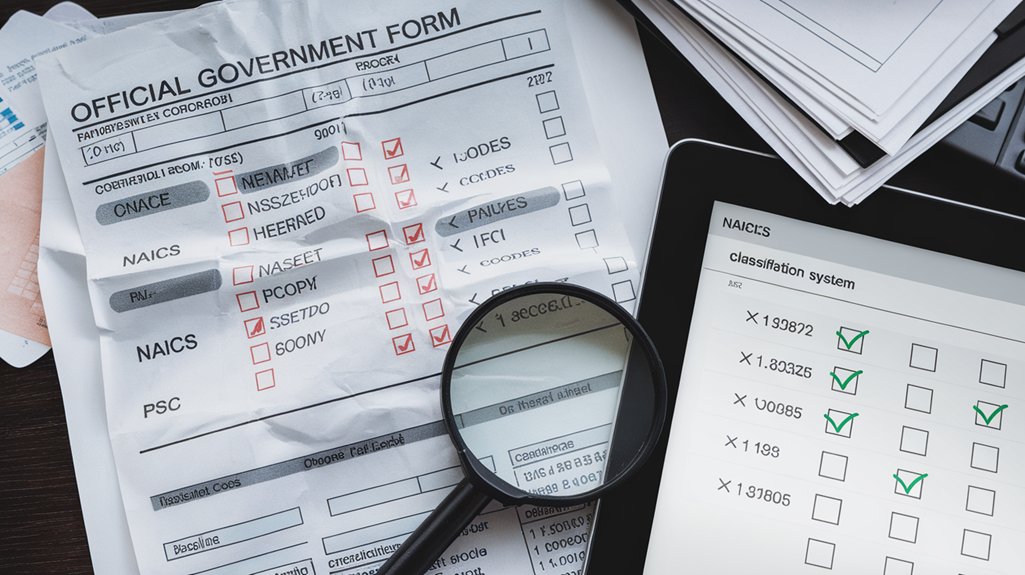Incorrect NAICS or PSC code entries in SAM.gov greatly limit contractors’ visibility to government buyers. These critical identifiers determine which solicitations reach vendors, and errors can exclude businesses from relevant opportunities. Common mistakes include insufficient research, misunderstanding code definitions, and typographical errors during registration. Contractors should regularly audit their codes, prioritize those reflecting core services, and maintain 5-15 relevant NAICS codes. Proper code selection directly impacts federal contracting success and revenue potential.
Table of Contents
ToggleHow Incorrect NAICS and PSC Codes Impact Your Federal Contract Opportunities

Steering through the federal contracting landscape requires careful attention to detail, particularly when it comes to North American Industry Classification System (NAICS) and Product Service Code (PSC) designations.
These codes serve as critical identifiers that determine which opportunities reach a business’s dashboard and which remain hidden.
When businesses implement ineffective code selection strategies, they risk becoming invisible to procurement officials searching for specific capabilities.
Procurement visibility depends entirely on accurate code assignments in SAM.gov and other federal databases.
A single misclassification can result in missed solicitations, reduced competitive advantages, and limited access to small business set-asides.
Contracting officers rely on these codes to identify qualified vendors, making proper classification essential for both government agencies seeking services and businesses hoping to provide them.
Government coding errors frequently filter out valuable contract opportunities that would otherwise match your business capabilities.
Maintaining accurate entity information in your SAM registration is equally important to prevent delays and complications in your contracting journey.
Studies show that maintaining multiple relevant codes in your registration significantly increases your chances of appearing in agency searches for qualified contractors.
Common Mistakes When Selecting Industry and Product Codes in SAM.gov

The selection of accurate NAICS and PSC codes represents a significant challenge for many businesses entering the federal marketplace. Among the most prevalent code selection strategies that fail are those based on insufficient research, where registrants choose codes without understanding their significance to federal contracting eligibility.
Common misconceptions include confusing NAICS definitions with PSC scopes and selecting overly broad subcategories that misrepresent actual capabilities. Many firms commit typographical errors during manual entry or use outdated codes that no longer reflect current classifications.
Another frequent misstep involves “code stuffing” – listing excessive unrelated codes to appear in more searches, which risks non-compliance and credibility issues.
Companies also often fail to validate their selections through cross-checks against past contract awards or neglect to use SAM.gov‘s built-in classification tools. Taking time to thoroughly complete Reps & Certs properly is essential for maintaining compliance and eligibility for government contracts.
Steps to Correct and Optimize Your NAICS and PSC Code Selections

Steering the correction process for NAICS and PSC codes requires systematic action to confirm compliance and enhance contracting opportunities. When errors are identified, contractors should immediately log into SAM.gov, navigate to the renewal section, and remove incorrect codes while adding accurate ones through the management interface. Ensuring accurate information across your SAM profile helps prevent name discrepancies that could affect your business credibility with government agencies.
For ideal code accuracy, businesses should:
- Use the PSC Selection Tool to align services with federal procurement categories
- Cross-reference NAICS with PSC suggestions for consistency
- Prioritize primary NAICS codes reflecting core revenue streams
- Include relevant secondary codes without diluting focus
Maintaining proper selection criteria involves quarterly reviews of codes, tracking federal RFPs for trending codes, and auditing past contract awards. Neglecting to update your NAICS codes may result in disqualification from contracts due to misalignment with project requirements. It’s recommended to maintain between 5 to 15 relevant NAICS codes that accurately reflect your business capabilities.
Pre-bid code audits should occur 48+ hours before submission to confirm SAM.gov reflects all updates.
Frequently Asked Questions
Can Misclassified NAICS Codes Affect Small Business Certification Status?
Misclassified NAICS codes greatly affect small business certification status and eligibility for government contracts.
Small business impact extends beyond simple administrative corrections, as size standards vary by industry classification. Certification eligibility depends on meeting specific employee or revenue thresholds defined by NAICS codes.
Businesses exceeding these thresholds lose their small business designation, eliminating access to set-aside contracts and special procurement programs designed for small businesses.
Regular verification guarantees continued compliance with size standards.
How Often Should Companies Review Their PSC Code Selections?
Companies should review their PSC code selections quarterly, at minimum, to maintain accuracy and compliance.
Reviews should also occur when:
- Business offerings change
- New contracts are pursued
- Annual SAM.gov profile updates are performed
- NAICS code updates are implemented
More frequent PSC code reviews may be necessary for companies with diverse government contracting activities or during periods of significant business development.
Regular audits prevent compliance issues and guarantee proper classification of services and products.
Are There Penalties for Intentionally Misrepresenting NAICS Codes?
Intentional misrepresentation of NAICS codes carries severe consequences.
Companies can face criminal penalties, substantial financial damages, and False Claims Act violations. The penalties may include liability for the full contract value, personal liability for company officers, and disqualification from future contracting opportunities.
Additionally, NAICS code compliance failures can trigger presumed loss determinations, where the government assumes no value was provided under the contract.
Companies should implement regular internal audits to guarantee accurate NAICS code representations.
Do Subcontractors Need Accurate NAICS Codes in SAM.Gov?
Yes, subcontractors must maintain accurate NAICS codes in SAM.gov. Proper subcontractor classification guarantees eligibility for set-aside contracts, compliance with federal regulations, and visibility to prime contractors seeking qualified partners.
Accurate reporting prevents disqualification from contracts, potential False Claims Act violations, and failed audits. Misrepresentation can result in lost opportunities, competitive disadvantages, and possible legal consequences.
Subcontractors should regularly review and update their NAICS codes to reflect their actual business activities, especially after the five-year NAICS code revisions.
Can Incorrect Codes Affect Past Performance Evaluations?
Incorrect codes can impact past performance evaluations, though indirectly.
While past performance evaluation criteria don’t explicitly include NAICS/PSC code accuracy, evaluators often cross-reference these codes when evaluating relevance of previous work. Mismatched codes may create perception gaps about a contractor’s experience in specific service categories.
Contracting officers retain discretion to regard code alignment during responsibility determinations. This discrepancy can prompt additional scrutiny during proposal evaluation, potentially affecting competitive standing.